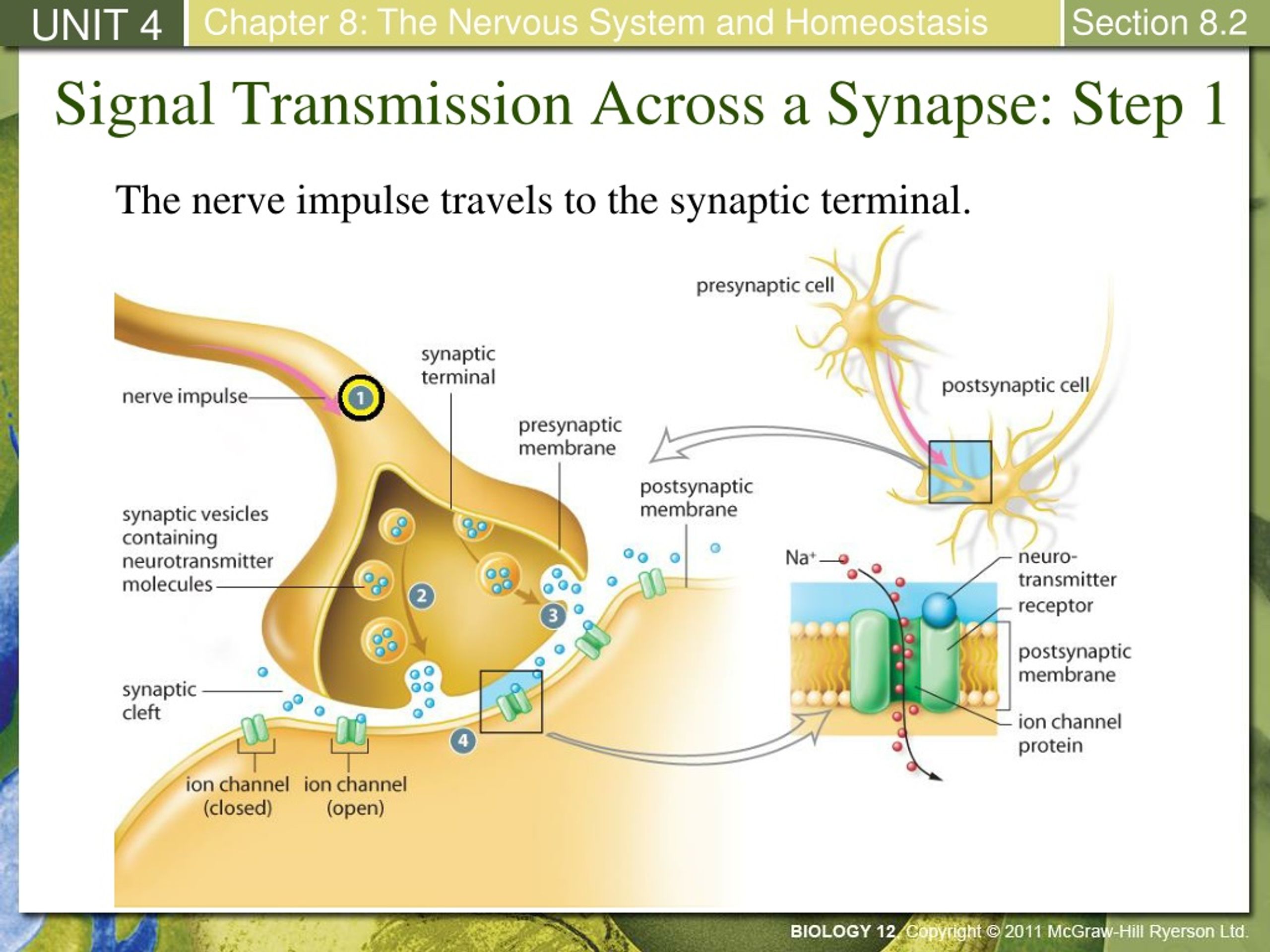- Synapse is the close proximity of the axon of one neuron and the dendrites or cyton of another neuron with a gap of just about 200A0. (1A0 =10 -10m).
- In other words, it is a junction between two successive neurons where the nerve impulse from the axon of one neuron gets transmitted to the dendrite of the next neuron with the help of chemical substance called neurotransmitters.
- The term synapse was first used by Sir Charles Sherrington (1857-1952), a British physiologist, for a neuron-neuron contact.
- In a synapse, the transmitting cell is called the presynaptic cell, and the receiving cell is termed as postsynaptic cell.
- A narrow gap, called synaptic cleft, separates the presynaptic cell from the postsynaptic cell.
- Hence, an action potential occurring in the membrane of the presynaptic cell cannot be directly transmitted to the membrane of the postsynaptic cell.
- A synapse between an axon of a motor neuron and a muscle fiber is called neuro-muscular junction.
- A synapse between an axon of a motor neuron and a glandular cell is termed as neuro-glandular junction.
- A synapse between a sensory neuron and a sensory receptor is known as neuro-receptor junction.
- Structure of these junctions and the transmission of nerve impulse across them is similar to those of neuron-neuron synapse.
- Transmission of the nerve impulse across a synapse is accomplished by the. Movement of Na + and K +. Release of a neurotransmitter by a dendrite. Release of a neurotransmitter by an axon. Release of a neurotransmitter by a cell body. All of these are correct.
- The impulses are transmitted across a synapse by neurotransmitter which is a Chemical. This flow is unidirectional as this chemical is secreted only in the axon side. This let the impulse pass through the synapse and then it is received by dendron. In This Nerve Impulses are transmitted Across a Chemical Synapse.
When the impulse reaches the pre synaptic knob, the impulse itself act as stimulus for the post synaptic neuron causing depolarization. Now the action potential generate in second neuron. Chemical transmission theory: Nerve impulse are conducted across the synapse with the help of chemical substances called neurotransmitter. The correct answer is (c). 'The transmission of the nerve impulse across a synapse is accomplished by the release of a neurotransmitter by an. See full answer below. The place where an axon terminal meets another cell is called a synapse. This is where the transmission of a nerve impulse to another cell occurs. The cell that sends the nerve impulse is called the presynaptic cell, and the cell that receives the nerve impulse is called the postsynaptic cell.

Mechanism of transmission of nerve impulse at a synapse:
1. When an impulse arrives at a synaptic knob of the axon, it depolarizes the presynaptic membrane and increases its permeability to calcium ions (Ca++).
2. Ca++ ions from the synaptic cleft pass into the synaptic knob via voltage- gated channels.Sudden rise in the cytosolic concentration of Ca++, causes small synaptic vesicles present there to secrete chemical substances called neurotransmitters and release into the synaptic cleft by exocytosis through the presynaptic membrane. A common neurotransmitter is Acetylcholine.
3. Acetylcholine diffuses across the synaptic cleft and attaches to special protein molecules that act as the acetylcholine receptors and are present on the ion channels in the membrane of the dendrite of the next neuron. The dendrite membrane at the synapse is thickened also called postsynaptic membrane.
4. The combination of the neurotransmitter with its receptors opens channels to let the ionic flow through the channels. The Na+ ions enter and K+ ions leave the dendrite down their concentration gradients. This causes the depolarization of the postsynaptic membrane and initiates a new action potential.
5. The new action potential passes as a wave (nerve impulse) along the new neuron.
How Does A Nerve Impulse Cross The Synapse
6. The neurotransmitter, acetylcholine is inactivated by an enzyme, acetylcholinesterase, present in the postsynaptic (dendrite) membrane as well as in the synaptic cleft. The enzyme splits acetylcholine by hydrolysis into its components, acetic acid and choline. This allows the membrane to repolarize. The constituents of acetylcholine are inactive and thus stimulation of the dendrite is avoided.

7. The constituents return by diffusion to the axon where these are recombined into acetylcholine with the help of necessary synthesizing enzymes.
- The synapse, thus, cannot transmit an impulse in the reverse direction as the dendrite cannot secrete acetylcholine or any other chemical transmitter.

Transmission of Nerve Impulse at a Synapse
Generating Nerve Impulses
A nerve impulse, like a lightning strike, is an electrical phenomenon. A nerve impulse occurs because of a difference in electrical charge across the plasma membrane of a neuron. How does this difference in electrical charge come about? The answer involves ions, which are electrically charged atoms or molecules.

How Is A Nerve Impulse Transmitted Across A Synapse Will

Resting Potential
When a neuron is not actively transmitting a nerve impulse, it is in a resting state, ready to transmit a nerve impulse. During the resting state, the sodium-potassium pump maintains a difference in charge across the cell membrane of the neuron. The sodium-potassium pump is a mechanism of active transport that moves sodium ions out of cells and potassium ions into cells. The sodium-potassium pump moves both ions from areas of lower to higher concentration, using energy in ATP and carrier proteins in the cell membrane. Figure (PageIndex{3})shows in greater detail how the sodium-potassium pump works. Sodium is the principal ion in the fluid outside of cells, and potassium is the principal ion in the fluid inside of cells. These differences in concentration create an electrical gradient across the cell membrane, called resting potential. Tightly controlling membrane resting potential is critical for the transmission of nerve impulses.
